Compatible with cloning and sequencing.
Use UV or blue LED for GelGreen® with SYBR® settings.
How Safe is Your Gel Stain?
A number of ethidium bromide (EtBr) alternatives are marketed as being safe. In fact, many so-called “safe” gel stains contain dyes that are well known to bind DNA in living cells, with cytotoxic effects. GelRed® and GelGreen® are highly sensitive gel stains designed to be non-toxic and non-mutagenic by virtue of being cell membrane-impermeant, so they cannot enter living cells. Download our white paper to learn more.
Safer alternatives to EtBr, SYBR® Safe, and others
EtBr has been the predominant dye used for nucleic acid staining for decades because of its low price and generally sufficient sensitivity. However, EtBr is a highly mutagenic material. The safety hazard and costs associated with decontamination and waste disposal can ultimately make the nucleic acid dye expensive to use. For this reason, various ethidium bromide alternative DNA gel stains have become commercially available in recent years. Although these alternative nucleic acid staining dyes are marketed as having low mutagenicity, they often have to sacrifice other aspects of the dyes. For example, SYBR® Safe has very limited sensitivity while SYBR® Green and SYBR® Gold are much less stable than EtBr. In addition, many so-called “safe” DNA dyes like Midori Green, GreenSafe, SafeView™, and RedSafe™ not only have low sensitivity, but also readily penetrate living cells to bind DNA, and some are cytotoxic. See our Gel Stains Comparison for details.
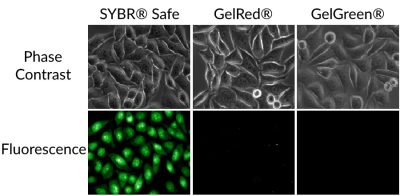
Non-toxic, non-mutagenic, and non-hazardous for disposal
To make GelRed® and GelGreen® safe, scientists at Biotium used a novel yet very simple concept: reduce genotoxicity by preventing the dyes from entering living cells. We believe that a DNA-binding dye can be made non-mutagenic or substantially so by denying its chance to be in contact with genomic DNA in living cells. Thus, we engineered the chemical structures of GelRed® and GelGreen® such that the dyes are incapable of crossing cell membranes. The Ames test confirmed that GelRed® and GelGreen® are non-mutagenic at concentrations well above their working concentrations used for gel staining. Furthermore, environmental safety tests showed that GelRed® and GelGreen® are nonhazardous and non-toxic to aquatic life. As a result, GelRed® and GelGreen® can be disposed of down the drain or thrown away in the regular trash. For more information, please download the GelRed® and GelGreen® Safety Report.
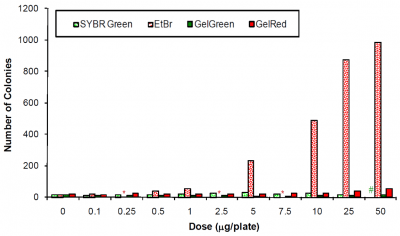
Superior sensitivity and flexible applications
GelRed® and GelGreen® are highly sensitive either as precast gel stains or post gel stains. GelRed® is much more sensitive than EtBr, and unlike SYBR® Gold, GelRed® can also be used as a highly sensitive precast gel stain. GelRed® is also available as a convenient prestain loading buffer. GelGreen® is spectrally similar to SYBR® Safe but is far more sensitive, and can be used with blue light gel imaging systems like the DarkReader®. PAGE GelRed® is designed for staining DNA in acrylamide gels. Another major advantage of GelRed® and GelGreen® DNA stain is their remarkable stability. You can store and handle the two nucleic acid staining dyes the same way you do with EtBr. For convenience, GelRed® and GelGreen® are also available in pre-coated agarose formats. For detailed protocols for use of the DNA stains, please download the GelRed® Product Information Sheet or GelGreen® Product Information Sheet.
Features
- More sensitive than EtBr, SYBR® Safe, and others
- Use in precast or post-stain
- Compatible with downstream cloning and sequencing
- GelRed® available in 6X loading buffer format
- PAGE GelRed® for acrylamide gels
- GelRed®: use UV transilluminator and EtBr filter
- GelGreen®: Use UV or blue LED and SYBR® filter, or our new Gel-Bright™ Laser Diode Gel Illuminator
GelRed® Is Superior to EtBr
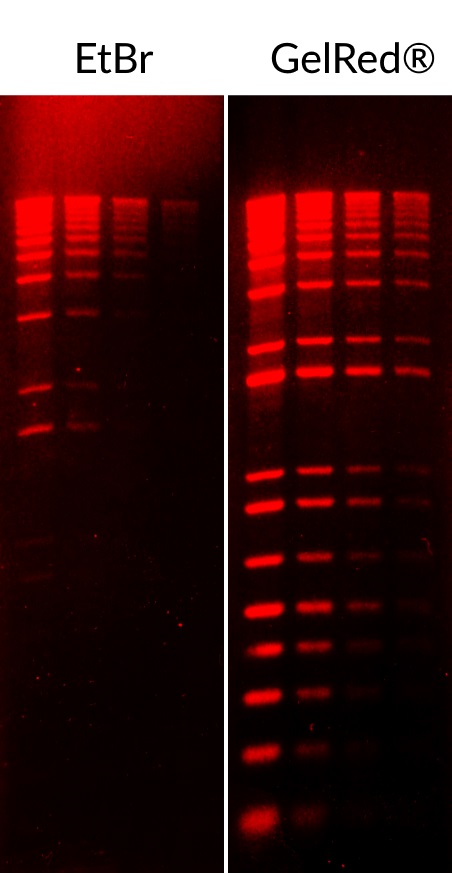
GelGreen® Is Unmatched by SYBR® Safe
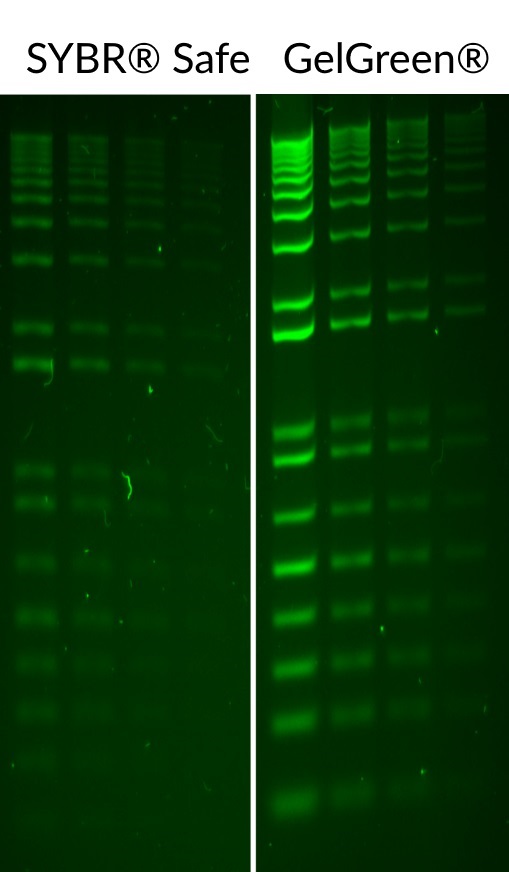
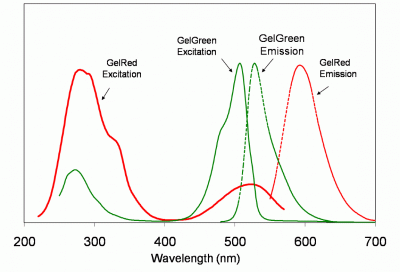
Click here to download an App Note on using GelRed® and GelGreen® on the UVP GelDoc-It® imaging system.
Click here to download an App Note on using GelGreen® on the UVP GelDoc-It® imaging system with the Visi-Blue™ Converter Plate.
GelRed® & GelGreen® DNA Agarose Gel Stain Formats
| Product Name | Catalog Number | Size |
|---|---|---|
| GelRed® 10,000X in water | 41003-T | 0.1 mL (Trial Size) |
| 41003 | 0.5 mL | |
| 41003-1 | 10 mL | |
| GelGreen® 10,000X in water | 41005 | 0.5 mL |
| 41005-1 | 10 mL | |
| GelRed® 3X in water | 41001 | 4 L |
| 6X GelRed® Prestain Loading Buffer, Orange Tracking Dye | 41010 | 1 mL |
| GelRed® Prestain Plus 6X DNA Loading Dye | 41011 | 1 mL |
| GelRed® Agarose LE | 41029-5G | 5 g |
| 41029-50G | 50 g | |
| GelGreen® Agarose LE | 41030-5G | 5 g |
| 41030-50G | 50 g |
Choose the Right Stain for Your Application
| Product / Method | Procedure | Advantages | Disadvantages | Recommended for |
|---|---|---|---|---|
| DNA staining with EMBER™ Ultra DNA Gel Kit | Agarose is supplied pre-coated with EMBER™ Ultra Dye, just dissolve, heat, and pour. | • Safer and more convenient, no need to handle concentrated dye • Superior sensitivity, detect as little as ≤1 ng DNA • No need for post-electrophoresis staining • Optimal for blue LED gel imagers |
• Not suitable for PAGE, DGGE, EMSA, or PFGE gels • Dye may cause band migration issues when loading larger amounts of DNA (more than ~200 ng/band), or for some restriction digests |
• Routine agarose gels |
| RNA staining with EMBER™ Ultra RNA Gel Kit | Agarose is supplied pre-coated with EMBER™ Ultra Dye, just dissolve, heat, and pour. | • Safer and more convenient stain for RNA, no need to handle concentrated dye • Superior sensitivity, detect as little as ≤5 ng RNA • No need for post-electrophoresis staining • Included loading dye contains formamide for denaturing • Optimal for blue LED gel imagers |
• Will stain DNA as well as RNA • Dye may cause band migration issues when loading larger amounts of RNA (more than ~200 ng/band) |
• Routine RNA gel electrophoresis • Evaluate total RNA integrity and DNA contamination |
| DNA prestaining with GelRed® Prestain Plus 6X DNA Loading Dye | GelRed® loading buffer is added directly to the DNA sample before loading | • Fast & simple: one-step sample loading & DNA staining • Less concentrated dye for safer handling • Can re-run a gel to use empty lanes |
• Not recommended for PAGE, DGGE, EMSA, or PFGE gels • Dye may cause band migration issues when loading larger amounts of DNA (more than ~100 ng/band), or for some restriction digests |
• Routine agarose gels • Recommended loading 50-200 ng ladder or 2-5 uL PCR product ( ~100 ng/band or less) |
| Precast staining with GelRed® 10,000X in water or GelGreen® 10,000X in water |
GelRed® or GelGreen® is mixed with molten agarose before gel casting | Familiar protocol, rapid results | ||
| Precast staining with GelRed® Agarose LE or GelGreen® Agarose LE |
Agarose is supplied pre-coated with GelRed® or GelGreen®, just dissolve, heat, and pour | Safer & more convenient, no need to handle concentrated dye | ||
| Post-electrophoresis staining with GelRed® 10,000X in water or GelGreen® 10,000X in water – or – GelRed® 3X in water |
No fluorescent dye is added to the gel, it is stained in 3X GelRed® or 3X GelGreen® solution after electrophoresis | • Most accurate sizing/sharpest bands • Staining solution can be re-used • Enhance sensitivity by adding NaCl |
Extra staining step (up to 30 minutes) after electrophoresis (some customers report good results after only 5 minutes if dye is not reused) | • Highly accurate band sizing • Gels with more than ~100 ng DNA per band • Analyzing restriction digests |
| Post-electrophoresis staining of PAGE gels using PAGE GelRed® 10,000X or 1X in water | No fluorescent dye is added to the gel, it is stained in 1X PAGE GelRed® solution after electrophoresis | • Formulated for efficient penetration and staining of polyacrylamide gels • Like the classic GelRed®, it is safe and environmentally friendly |
Extra staining step of approx. 30 minutes after electrophoresis | Staining of nucleic acids in PAGE gels |
VIEW PRODUCTS
GelGreen® Nucleic Acid Gel Stain
41004, 41005, 41005-1, - 41005-TView allHide
GelRed® Nucleic Acid Gel Stain
41001, 41002, 41003, 41002-1, 41003-1, - 41003-TView allHide
6X GelRed® Prestain Loading Buffer with Orange Tracking Dye
GelRed® Agarose LE
41029-5G, - 41029-50GView allHide
GelGreen® Agarose LE
41030-5G, - 41030-50GView allHide
